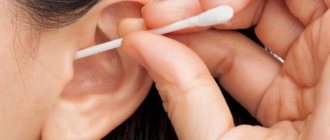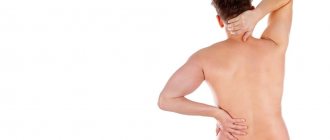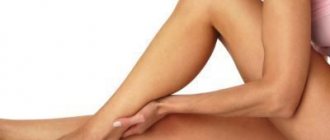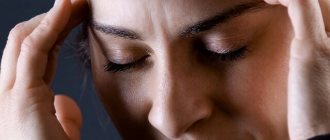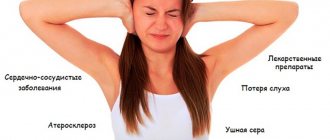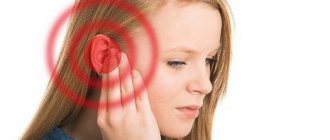Causes of goosebumps
The feeling of goosebumps has been familiar to mankind since ancient times. “Goose bumps”, “hair standing on end on the head” - such expressions are found in everyday life quite often, as well as numbness of the scalp, which we will talk about here. In some cases, this phenomenon is harmless and goes away on its own after some time.
Such cases include:
- sexual arousal;
- strong fear;
- feeling of sudden cold;
- sincere admiration;
- fright;
- pleasure;
- sudden sharp sounds (metal grinding on glass);
- general poor health;
- low temperature indoors or outdoors;
- high sensitivity of the skin.
Among the causes of goosebumps on the scalp are the following::
excess weight;- poor nutrition;
- sedentary lifestyle;
- sensitivity to weather changes;
- diabetes;
- smoking;
- systematic physical activity;
- stress;
- chronic fatigue.
In medicine, the feeling of goosebumps on the scalp is called pilomotor reflex , the manifestation of which is caused by sensitive peripheral nerves. This effect occurs due to strong stimulation of nerve endings associated with smooth muscles and human hair follicles.
The raising of the hairline is called piloerection. Temporary piloerection is a vestigial reflex. As a rule, it does not last long and disappears along with the reason that provoked it.
I would like to note that many people mistakenly confuse the feeling of “pins and needles” on the head with a burning sensation. You will learn more about the second disease from this article.
Goosebumps on the body, arms and legs
What we call goosebumps, medicine calls paresthesia.
Sometimes such sensations can appear due to pleasure from something or surprise at something, however, sometimes goosebumps are nothing more than a sign of a developing illness. Many diseases can provoke the appearance of paresthesia. The main ones are:
- A disease that is accompanied by changes in the cartilage tissues of the spine, disturbances in the structure and functionality of the intervertebral discs. Formication often appears in the upper extremities. At the same time, the appearance of weakness and pain in the limbs and muscles is noted.
- Degenerative-dystrophic changes in peripheral nerves.
- Increased amount of glucose in the blood.
- In case of intoxication. Most often, goosebumps are felt in the fingers of the lower and upper extremities, however, they can also appear in other parts of the body. At the same time, coordination of movements worsens.
- Lack of calcium and magnesium in the body. Goosebumps are felt in the upper and lower extremities. Symptoms of the disease such as convulsions, vomiting, loss of consciousness, dry skin, brittle nails, hair loss, and a feeling of stuffiness in the ears are added.
- Nerve fiber damage.
- Phlebeurysm. Goose bumps are felt in the lower extremities, along with this symptom the appearance of purple and bluish “stars” on the legs is noted.
- A neurological disease that manifests itself as sudden, severe headaches. Most often, goosebumps appear on the face and lower extremities.
- Raynaud's disease. Goosebumps appear on the fingers of the upper limbs. In addition, blueness of the skin on the fingers and pain in them are noted.
Can be all over the body
- A chronic disease of the arteries, which occurs due to disturbances in lipid and protein metabolism and is manifested by the deposition of cholesterol in the lumen of blood vessels.
- Lack of vitamins B, C. In this case, goosebumps run down your legs and arms. In addition, the person’s condition is complemented by headache, arrhythmia, swelling, changes in stool, memory impairment, etc.
- Inflammatory joint disease.
- Inflammation of the walls of blood vessels.
- Stroke.
- A disease that manifests itself as damage to the membrane of the nerve fibers of the brain and spinal cord. Goosebumps can be felt in any part of the body, and the manifestation of the disease is accompanied by a temporary deterioration in visual function.
- A disorder of the nervous system, which manifests itself as irritability, drowsiness, and fatigue. Goosebumps can be felt all over the body.
- A viral infection that causes skin pain and rashes. Goose bumps can appear in any part of the body, however, they mainly occur in the ribs area. The place where the goosebumps are felt, itches and burns; after some time after the manifestation of such a symptom, bubbles with liquid form at the site.
May be caused by diseases
- A disease that irreversibly affects the human nervous system. Goosebumps are felt in the affected area of the body. Some time after contracting the disease, photophobia, sound fear, etc. develop.
- Nerve damage during tooth extraction.
- Neoplasms in the parietal lobe of the brain. Goosebumps may be all over the body. In addition, they are accompanied by serious signs of a developing disease - loss of the ability to recognize objects by touch, write, and perform complex tasks and actions.
This symptom is accompanied by many diseases. Let's consider the main ones in more detail.
Hypovitaminosis B1
Vitamin B1 is needed for the normal functioning of the nervous system. It is involved in the production of acetylcholine - a substance that allows a nerve impulse to reach the muscle, intestines, sweat gland, heart - and transmit its command to it. Its insufficient intake from food or acceleration of its breakdown leads to:
- feeling of pins and needles on the legs and arms;
- irritability;
- headache;
- memory impairment;
- constipation;
- increased heart rate;
- pain in the heart;
- swelling;
- shortness of breath;
- sometimes even paralysis and cardiovascular failure.
Such symptoms require prompt diagnosis and treatment: administration of synthetic vitamin thiamine and diet correction.
Hypoparathyroidism
This is a reduced function of the parathyroid glands, in which the level of calcium in the blood decreases. It manifests itself not only as goose bumps in the limbs, but also:
- painful contractions of the muscles of the limbs, body and face: the arm is brought towards the body, it is “bent” at the wrist and elbow joints, the corners of the mouth are lowered, the eyelids are lowered by half, the body is arched back;
- swallowing is paroxysmally impaired;
- there is a stabbing pain in the abdomen;
- there may be vomiting, diarrhea;
- fainting occurs;
- twilight vision is impaired;
- "pawns ears;
- there are pains and interruptions in the heart;
- hair becomes thinner, the number of hair shafts falling out increases;
- the skin is peeling;
- a large number of teeth are affected by caries;
- nails become dull;
- With prolonged absence of therapy, cataracts develop.
Here the same symptoms develop as with hypoparathyroidism, but they are not as pronounced and occur more easily. Often, the pathology is manifested only by painful spasms of the muscles of the limbs and face, which immediately follow goosebumps, increased heart rate, trembling and recurrent vomiting. With an extremely low level of this electrolyte in the blood, difficulty breathing may develop until it stops, and painful arching of the entire body.
This condition manifests itself:
- weakness;
- lack of appetite;
- nausea, vomiting;
- trembling of the body or individual muscles;
- Convulsions may occur in which the entire body contracts or arches. This is most common in children.
The appearance of goose bumps can be caused by taking drugs such as: Ofloxacin, Protionamide, Isonazid, Cycloserine, drugs against epilepsy and blood pressure lowering drugs.
Arrhythmias
In the case of the development of attack-like (paroxysmal) rhythm disturbances, a person may notice:
- “goosebumps” running over the body;
- chills at normal body temperature.
This state lasts from ten minutes or more; most often develops at night.
Brain stroke
Paralysis or partial immobility of the limbs on one side may be preceded by a feeling of numbness and crawling, sometimes on the opposite side. There is also a headache, there may be short- or long-term loss of consciousness, focal symptoms are observed: facial asymmetry, different widths of the palpebral fissures, inability to speak or understand speech.
A tumor or encephalitis that develops in the lobe responsible for sensitivity is accompanied by other symptoms: the inability to perform complex actions, failure to recognize objects if you close your eyes and feel them with your hands, loss of the ability to write. There may also be loss of half of the visual field and loss of awareness of one's own body diagram.
This condition occurs after a viral infection (mainly colds and herpes), or intestinal infection caused by the Campylobacter bacterium or enteroviruses.
Here, in the period from 5 to 21 days after the illness, antibodies are formed to certain areas of the spinal nerve roots. This is manifested by the appearance of pins and needles on the legs, the range of movements gradually decreases, and sensitivity is impaired. The process may appear immediately on your hands.
Head injury
A brain contusion can lead to the appearance of pins and needles on both one and two sides. After this, loss of sensation may develop.
Shingles
The disease is caused by the same virus as chickenpox; occurs in those who have already had it. It manifests itself as the appearance of goosebumps in the projection of any nerve, but more often - one of the intercostal nerves. Goosebumps precede the appearance of redness here, on which bubbles with transparent contents soon appear. The affected area burns and hurts.
Multiple sclerosis
This is an autoimmune pathology when one’s own antibodies begin to attack the membrane of most nerve fibers, as a result of which the latter become “naked” and begin to destroy themselves. There is no clear sequence or algorithm for damage to fibers, so it is difficult to recognize the disease.
Most often, it begins with deterioration of vision in one eye, the sensation of a foreign body in it, and the appearance of blurred contours of the objects in question. This condition lasts about a week, then goes away on its own, but not completely. Subsequently, the symptom will recur. Gradually, it leads to disruption of coordinated eye movements and a change in the normal reaction of the pupils to light.
Also, the initial manifestations of the disease include goosebumps, burning, numbness or tightening of the skin that occurs on any part of the body. It goes away on its own and often does not serve as a reason to contact a neurologist or therapist.
Polyneuropathy
This disease is characterized by damage to the peripheral nervous system due to poisoning (including alcohol surrogates), metabolic disorders (mainly due to diabetes mellitus). It is dangerous because the disconnection of nerves, starting from distant parts of the body (fingers and toes), spreads closer and closer to the respiratory muscles, and can also involve the nerves that command the contraction of the muscles responsible for breathing.
Polyneuropathy manifests itself as a deterioration in the motor activity of the legs and arms, starting with the fingers, the appearance of goosebumps and numbness in these areas, and the gradual “turning off” of sensitivity in the areas of socks and gloves.
If goosebumps crawl on the skin of your face and hands, this may be one of the following pathologies.
Migraine
At first, goosebumps appear on the face (especially around the mouth) and hands, then a headache develops mainly in one half of the head. In this case, paresthesia should be regarded as a migraine aura - a condition that precedes an attack of pain.
What can cause: diseases
Most often, goosebumps on the scalp are observed in people prone to emotional experiences, nervous breakdowns, excessive suspiciousness and causeless anxiety.
There are a number of diseases that are characterized by the appearance of such sensations . These include:
- avitaminosis;
- hypoparathyroidism;
- atherosclerosis;
- neuropathy;
- osteochondrosis;
- diseases of the cardiovascular system;
- microstroke.
Vitamin deficiency provokes peeling of the scalp and muscle weakness throughout the body .
Hypoparathyroidism causes nervous tension and numbness in the limbs. With diseases of the cardiovascular system, goosebumps appear on the right side of the head, disrupt the blood circulation and can provoke a mini-stroke. Goosebumps on the scalp also appear with osteochondrosis of the cervical spine, causing headache, numbness, tingling in the neck muscles.
With atherosclerosis and neuropathy of the greater occipital nerve, in addition to unpleasant tingling, pallor and decreased sensitivity of the skin are also observed.
Types and mechanism of “goosebumps”
The sensation of tingling and crawling is medically called “paresthesia.” They appear in response to irritation of nerve endings, the brain or spinal cord. The nature of this phenomenon is as follows: the sensitive nerve ending receives several different unrelated signals at once, layering on top of each other. As a result, the nerve does not know how to react correctly to this variety, and “turns on” numbness, burning, “pins and needles” or tingling.
Paresthesia is usually felt below the irritated area of the nerve. They may be accompanied by “goose bumps” - “pimples” in the area of hair growth, which is an analogue of the puffiness of fur or quills in animals.
Paresthesias can be:
- temporary, occurring when sitting in an uncomfortable position, freezing, sexual arousal, a feeling of euphoria from listening to music or when negative emotions appear. They are usually described as “pins and needles on your legs” and go away when the irritating factor stops. Not accompanied by cramps, pain or sensory disturbances;
- chronic, recurring. They are signs of the disease, and can be accompanied by two types of symptoms:
- indicating damage to the nerve fiber. These are: numbness in the limbs or only in the fingers, tingling sensation, goosebumps. Sometimes local twitching (convulsions) develops here;
- indicating damage to those nerves that are connected to the vessels of this area. This is evidenced by: pale skin, deterioration of temperature and pain sensitivity, cool temperature, hair loss.
Transient (temporary) paresthesia is a variant of the norm and does not require medical intervention. If “goosebumps” run without any visible effect on the skin, you definitely need to look for their cause and eliminate it.
What to do if this phenomenon does not go away?
There are times when goose bumps on the scalp last for quite a long time and do not go away on their own . If such a phenomenon takes a person by surprise, it is necessary to ensure maximum comfort for the patient:
- lay on the bed with your head raised;
- bring fresh air into the room;
- measure pressure;
- give a sedative;
- apply ice to the back of the head;
- give a light head massage;
- ensure high-quality and continuous breathing (if necessary, relieve the patient from tight clothing);
- exclude any sudden movements;
- remain in a horizontal position until the ambulance arrives.
If you have vitamin deficiency, you need to take vitamins C, B1 and D, and include milk, sea fish, nuts, herbs and wholemeal bread in your daily diet.
Special vitamin and hormonal therapy will help to cope with hypoparathyroidism; in case of cardiovascular diseases, you will need to undergo a comprehensive examination (ultrasound, ECG), give up bad habits, and also limit your consumption of animal fats.
After suffering a micro-stroke, an unpleasant phenomenon can be eliminated with the help of therapeutic and relaxing massage , exercise therapy, a special diet, breathing exercises and physical procedures; for osteochondrosis, complex treatment with medications and therapeutic massage.
Atherosclerosis can be cured with the help of special drugs (satins, fibrates) and surgical intervention - bypass surgery, vascular replacement, angioplasty. To eliminate the disease due to neuropathy, you need to consult a neurologist and undergo a course of treatment.
Common causes of goose bumps
The reason for this is muscle contraction around the hair follicles. This is an evolutionary atavism with the help of which wild animals protect themselves in case of danger by grouping and increasing their body area.
In humans, this ability has practically disappeared, and only reminds us of itself when goosebumps run through the body. This often happens when we feel an emotional surge (delight, horror, excitement or religious ecstasy) or simply freeze.
A similar sensation occurs when the body suffers from a lack of oxygen or blood in the tissues. Natural, non-pathological goosebumps are not accompanied by pain. If paresthesia bothers you often and for no reason and is accompanied by numbness and pain in the limbs, you should consult a doctor.
In a normal state, the appearance of goosebumps on the skin is very fleeting and does not cause discomfort; this occurs due to the release of adrenaline into the blood. However, there are also unhealthy goosebumps. Why do they run around the body?
There may be several answers:
- This may be a symptom of a lack of vitamins, especially groups B and C (the skin loses its properties and malfunctions occur);
- Lack of collagen in tissues leads to loss of elasticity of the walls of blood vessels and their fragility and blockage;
- The skin suffers from a lack of oxygen, its elasticity is reduced, which is why the epidermis peels off and irritation and allergic reactions appear;
- The need for vitamin B1 and vitamin D is characterized by a burning sensation, general weakness, skin irritation, and decreased appetite. In this case, in addition to goosebumps, there is insomnia, constant fatigue and frequent cramps.
Such circumstances require treatment not only of goosebumps, but of their indirect cause - vitamin deficiency.
- If you experience any of these symptoms, talk to your doctor.
- He will help you choose a vitamin complex and the right diet. Be sure to eat seafood, yolks, animal liver, drink fresh milk, this will help increase the level of vitamin D in the body.
- Replenish the lack of vitamin B with cereals, legumes, nuts, rye bread and boiled potatoes.
- Everyone knows where to get vitamin C - in sour fruits, citrus fruits, apples, greens and natural juices.
Pay attention to the condition of your skin. If it becomes rough and inflamed, you should be wary of follicular hyperkeratosis, which causes the epidermis to become keratinized. This process is similar in appearance to cellulite, but is accompanied by burning, itching and blockage of the hair follicles. The reasons may be different: heredity, metabolic problems, hormonal imbalance or incorrectly selected hygiene products. In this case, a dermatologist and a competent choice of body cosmetics will help you.
Diagnostics
To correctly diagnose the disease, the doctor prescribes these types of examinations:
- general blood and urine analysis;
- ECG;
- Ultrasound of the heart and kidneys;
- consultation with a neurologist;
- MRI of the brain and spinal cord;
- radiography (in some cases).
IMPORTANT. To treat goosebumps on the scalp, conservative methods are used: tablets, physiotherapeutic procedures, massage, special gels. For chronic symptoms, self-treatment is strictly contraindicated - additional complications, disability, and even death may occur.
How to call?
The feeling of goosebumps can be quite pleasant if you induce it yourself (or if you cause goosebumps to “run” on the skin of a loved one). To achieve this effect is very simple, you can:
- Run over the skin with the tips of your nails (without pressing), a feather or other suitable object.
- Blow on the skin (especially hot skin).
- Touch your skin with an ice cube.
Experts have come to the conclusion that a variety of factors that stimulate the activity of the sympathetic nervous system, which normally responds to a threat, can trigger the feeling of goosebumps on the skin. Such a reaction can occur due to unexpected influence:
- Music.
- Specific sounds - from the rustling of leaves to the scratching of nails on a board.
- Tastes (especially strong ones).
- Movies.
It is impossible to predict in advance exactly how the body will react to a particular stimulus. But it is known for certain that the ability to cause pleasant “goosebumps” helps reduce pain or increase sexual pleasure.
Causes of goosebumps in the head
Paresthesia is a sensitivity disorder associated with damage to parts of the nervous system.
The reasons for the sensation of goose bumps in women and men correlate with diseases of the nervous system or circulatory disorders.
Short-term disturbances can be provoked by factors such as prolonged stay in an uncomfortable position, a stressful situation, hypothermia, irritation of superficial nerve endings (impact, compression).
Drug therapy
To treat sensitivity disorders, when there is a sensation of hair moving on the head, medications are prescribed, primarily painkillers and anti-inflammatory drugs (Indomethacin, Reopirin, Sedalgin), which eliminates pain and manifestations of paresthesia. Main groups of drugs:
- Antiepileptics, anticonvulsants (Carbamazepine, Clonazepam).
- Stimulators of metabolic processes (Solcoseryl, Actovegin).
- Antiviral (Acyclovir, Herpesin).
- Muscle relaxants (Baclofen, Mydocalm).
- Correctors for cerebral blood flow disorders (Cavinton, Vinpocetine).
Glucocorticoid drugs (Prednisolone, Hydrocortisone) are prescribed to suppress the autoimmune reaction. For polyradiculoneuritis, antibiotics are prescribed (Gentamicin, Benzylpenicillin). In case of toxic lesions, intravenous administration of Hemodez and Glucose is recommended (detoxification therapy).
To improve the transmission of nerve impulses in muscle tissue, Proserin (a cholinesterase inhibitor, effective for myasthenia gravis and movement disorders associated with damage to nerve fibers) is prescribed. In the treatment of alcoholic polyneuropathy, vasodilators (Xanthinol nicotinate, Bendazole) are prescribed.
ethnoscience
To treat sensitivity disorders at home, decoctions and infusions are used, prepared from chicory and parsley roots, lingonberries and cranberries, flax seeds and dill, nettle leaves, leaves and flowers of echinacea and lavender.
What to pay attention to
If you regularly experience a tingling sensation in the right or left side of your head, you need to pay attention to the accompanying symptoms. These include visual and hearing impairment, dysphagia (swallowing disorder), speech dysfunction, dizziness, imbalance, nausea and vomiting, and persistent sleep disturbance. Many of the symptoms listed indicate the presence of a disease.
To find out what gives you goosebumps, you need to make an appointment with a doctor. There are many diseases and conditions that lead to sensitivity disorders. Having found out the causes of the disorders, the correct treatment can be prescribed.
Source: https://golovmozg.ru/zabolevaniya/prichiny-oschuscheniya-murashek-v-golove
Diseases that cause goosebumps
Very often, chills, tremors in the limbs, and numbness are mistaken for goose bumps. This is the result of a lack of iodine in the body and disruption of parathyroid secretion. These symptoms cannot be ignored; consult an endocrinologist to avoid autoimmune rejection of glandular cells.
Why do I have goosebumps on the left side of my body? If this happens to you, know that this is a sure sign of heart problems. If trembling, chills and anxiety come on suddenly and last more than 5 minutes, be sure to visit a cardiologist. After all, the cause of goosebumps on the left side of the body is most likely an arrhythmia or heart defect; perhaps you have problems with the heart valves. Paresthesia in this case signals a lack of blood flow and oxygen starvation of tissues associated with circulatory disorders.
This requires comprehensive diagnosis and treatment:
- blood pressure measurement;
- analysis of the amount of lipids, blood glucose levels;
- ECG examination, cardiogram and ultrasound of the heart muscle and blood vessels;
- analysis for diabetes mellitus and blood clotting;
- a special diet to cleanse the blood and control sugar levels.
If you are concerned about tingling and numbness in your legs, swelling, fatigue and heaviness, get a comprehensive physical examination. After all, varicose veins or problems with the urinary system and kidneys are possible. Pay attention to the condition of the veins, the presence of plaques and capillary webs.
- The reason for the appearance of goosebumps throughout the body and in the head area is a lack of oxygen in the tissues, which is explained by impaired blood supply to the brain, blockage of blood vessels or heart disease.
- This condition is especially common in older people suffering from atherosclerosis. This is a job for a phlebologist who can determine the exact cause of fasting and identify areas of blockage and thin the blood.
- For people at risk of diabetes, monitoring their sugar levels is very important. And if you feel that goosebumps, like little midges, are periodically moving around different parts of the body, check your sugar and cholesterol. Now you know why goosebumps run all over your body and head, and what causes this phenomenon.

